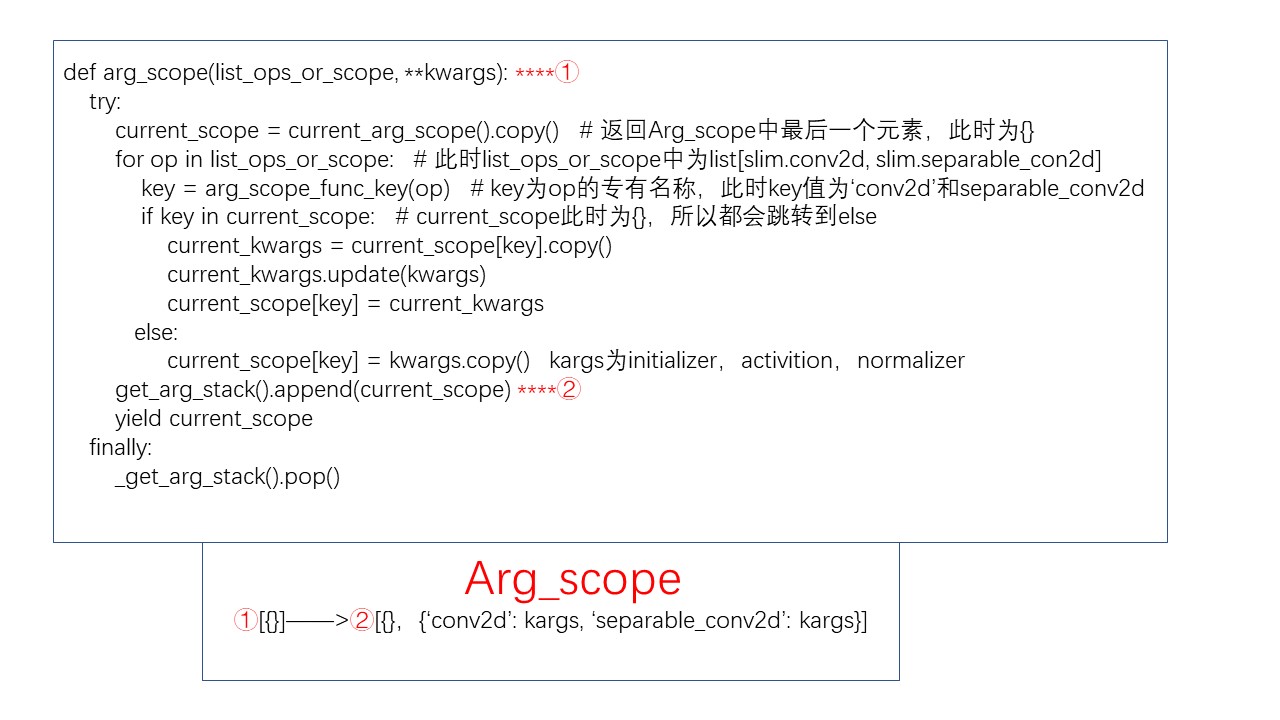准备工作
我们先看一下arg_scope的函数声明:
@tf_contextlib.contextmanager def arg_scope(list_ops_or_scope, **kwargs):
有函数修饰符@tf_contextlib.contextmanager修饰arg_scope函数,我们先研究下这个函数修饰符。
@的作用
@之后一般接一个可调用对象(tf_contextlib.contextmanager),一起构成函数修饰符(装饰器),这个可调用对象将被修饰函数(arg_scope)作为参数,为其执行一系列辅助操作,我们来看一个demo:
import time def my_time(func): print(time.ctime()) return func() @my_time # 从这里可以看出@time 等价于 time(xxx()),但是这种写法你得考虑python代码的执行顺序 def xxx(): print('Hello world!') 运行结果: Wed Jul 26 23:01:21 2017 Hello world! 在这个例子中,xxx函数实现我们的主要功能,打印Hello world!,但我们想给xxx函数添加一些辅助操作,让它同时打印出时间,于是我们用函数修饰符@my_time完成这个目标。整个例子的执行流程为调用my_time可调用对象,它接受xxx函数作为参数,先打印时间,再执行xxx函数。
上下文管理器
既然arg_scope函数存在装饰器,那么我们应该了解一下@tf_contextlib.contextmanager装饰器提供了什么辅助功能,代码为:
import contextlib as _contextlib from tensorflow.python.util import tf_decorator def contextmanager(target): """A tf_decorator-aware wrapper for `contextlib.contextmanager`. Usage is identical to `contextlib.contextmanager`. Args: target: A callable to be wrapped in a contextmanager. Returns: A callable that can be used inside of a `with` statement. """ context_manager = _contextlib.contextmanager(target) return tf_decorator.make_decorator(target, context_manager, 'contextmanager') #会在下一篇介绍这个return语句的功能
上下文管理器――contextlib库
可以看到导入了contextlib库,这个库提供了contextmanager函数,这也是一个装饰器,它使被修饰的函数具有上下文管理器的功能。上下文管理器使我们能在执行一段代码块之前做一些准备工作,执行完代码块之后做一些收尾工作,同样先来看一个上下文管理器的例子:
import time class MyTimer(object): def __init__(self, verbose = False): self.verbose = verbose def __enter__(self): self.start = time.time() return self def __exit__(self, *unused): self.end = time.time() self.secs = self.end - self.start self.msecs = self.secs * 1000 if self.verbose: print "elapsed time: %f ms" %self.msecs with MyTimer(True): print('Hello world!') 类MyTimer中的__enter__和__exit__方法分别是准备工作和收尾工作。整个代码的执行过程为:先执行__enter__方法,__enter__方法中的返回值(这个例子中是self)可以用到代码块中,再执行语句块,这个例子中是print函数,最后执行__exit__方法,更多关于上下文管理器的内容可以看这,我的例子也是从那copy的。contextlib中实现上下文管理器稍有不同,一样来看个例子:
from contextlib import contextmanager @contextmanager def tag(name): print "<%s>" % name yield print "</%s>" % name >>> with tag("h1"): ... print "foo" 运行结果: <h1> foo </h1> tag函数中yield之前的代码相当于__enter__方法,yield产生的生成器相当于__enter__方法的返回值,yield之后的代码相当于__exit__方法。
arg_scope方法
这里我把arg_scope方法中代码稍微做了一些精简,代码如下:
arg_scope = [{}] @tf_contextlib.contextmanager def arg_scope(list_ops_or_scope, **kwargs): try: current_scope = current_arg_scope().copy() for op in list_ops_or_scope: key = arg_scope_func_key(op) if not has_arg_scope(op): # op是否用@slim.add_arg_scope修饰,这会在下一篇中介绍 raise ValueError('%s is not decorated with @add_arg_scope', _name_op(op)) if key in current_scope: current_kwargs = current_scope[key].copy() current_kwargs.update(kwargs) current_scope[key] = current_kwargs else: current_scope[key] = kwargs.copy() _get_arg_stack().append(current_scope) yield current_scope finally: _get_arg_stack().pop() # demo with slim.arg_scope( [slim.conv2d, slim.separable_conv2d], weights_initializer=tf.truncated_normal_initializer( stddev=weights_initializer_stddev), activation_fn=activation_fn, normalizer_fn=slim.batch_norm if use_batch_norm else None): with slim.arg_scope([slim.batch_norm], **batch_norm_params): with slim.arg_scope( [slim.conv2d], weights_regularizer=slim.l2_regularizer(weight_decay)): with slim.arg_scope( [slim.separable_conv2d], weights_regularizer=depthwise_regularizer) as arg_sc: return arg_sc
第一层

之后的层的处理就很类似,留给大家思考。
结语
回到我们开头提到的问题,不同层的参数是如何互相补充的?现在我们可以看到,参数存储在栈中,每叠加一层,就在原有参数基础上把新参数添加上去。
